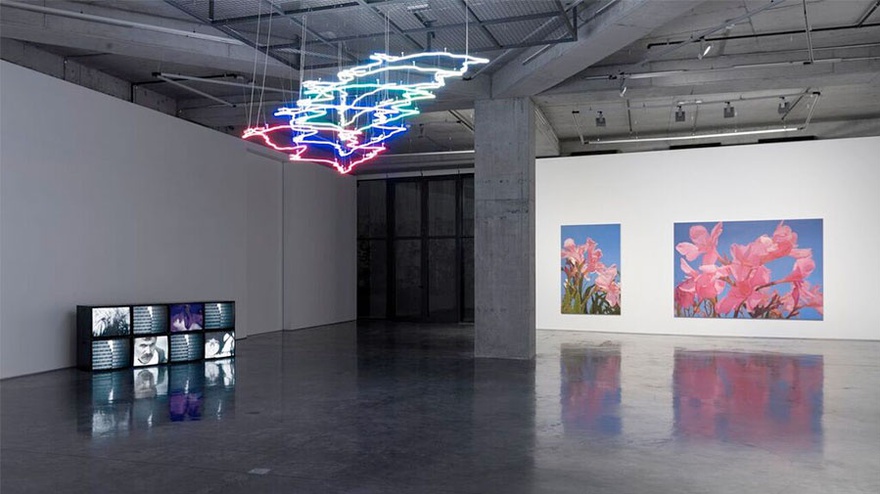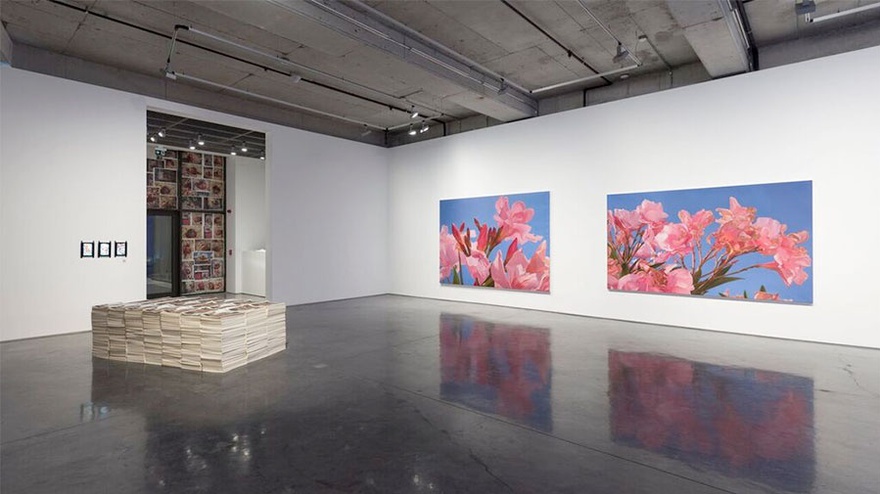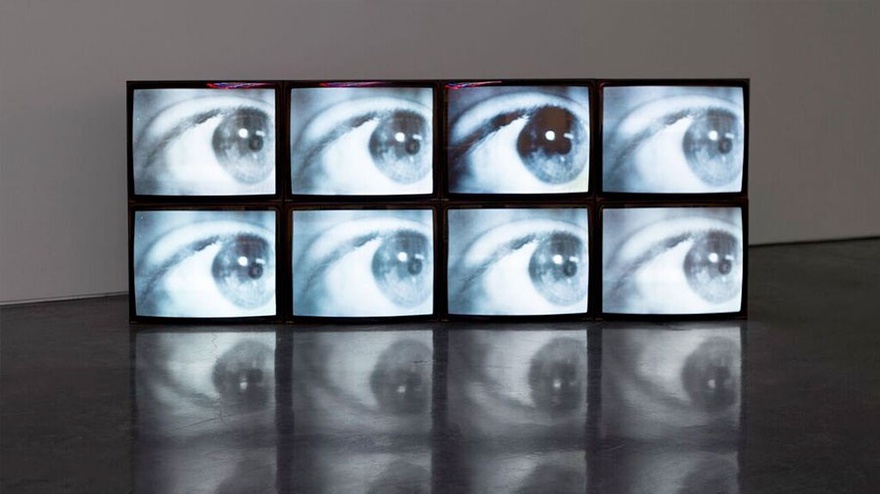Reviews
Mustafa Hulusi
Negative Ecstasy at Dirimart, Istanbul
On entering Mustafa Hulusi's exhibition Negative Ecstasy, curated by November Paynter at Dirimart's recently opened space in Dolapdere Istanbul, a neon mobile hangs from the ceiling above the large single gallery space. Titled Cyprus (2010–2016), five brightly lit tubes each depict the outline or coastal border of Cyprus, in red, blue, yellow, green, and white from the bottom to top, suspended one above the other. Each layer fans-out from an off-centre axis corresponding to the island's Turkish-occupied north-eastern promontory, meaning that when viewed from underneath or from a distance, multiple borders cross and overlap. The sculptural map does not depict the island's internal political border dividing the Greek and Turkish Cyprus over a 42-year period. However, multiple neon tubes create their own temporary borders, moving and creating multiple intersections depending on where the viewer is stood.
Below the neon mobile are a number of works that explore a sense of material displacement and the experience of images in the present. The photographic series Pomegranate (2015), for example, depicts the cracked leathery skins of rotting fruits on dusty arid earth, presented in images printed on newsprint contained in folios stacked and available for viewers to take away. The fruits were photographed in a neglected orchard in northern Cyprus, which Hulusi – a British artist of Turkish-Cypriot decent – has visited since childhood. Some pages inside the folios show another manifestation of the work, in which the pomegranate pictures are re-photographed as large-scale fly posters pasted across brick walls and advertising hoardings around the artist's home city of London. Pages included in the folios also cover the gallery's entrance, illuminating the newsprint pomegranates like monumental stain glass, isolated vanitas motifs simultaneously fixed in a photographic instant. As emblematic spheres, the pomegranates recall the whole world, the endangered earth. As singular organic forms, they might appear anthropomorphic or corporeal, representing the one and many in the mind's eye.
So how might Cyprus and Pomegranate be productively thought about together? A point of departure for Hulusi in this exhibition is the writings of the late French literary critic Georges Bataille. For Bataille, visual culture in the modern era has been alleviated from religiously motivated political didacticism, yet the viewing subject continues to mimetically measure their own sense of self against reified social phenomena.[1] In Hulusi's work, then, an allegorical status is maintained in that an image becomes a site of inquiry. In referencing man-made geopolitical borders and symbolic signifiers, works like Cyprus and Pomegranate might be conceived as a way to map identity, likely the artist's own. Rather than being markers of the artist's biography however, the deceptive simplicity of visual gestures renders singular or straightforward meanings unstable. Borders and arbitrary symbolisms are resisted both materially and discursively in the way images are constantly framed and reframed. Hulusi's works share a certain contemporaneity, relying on individual or personal interpretations just as much as general symbolic associations encountering the works might prompt.
Likewise, a series of four large-scale wall-mounted oil paintings, titled Oleander (2016), show groupings of Mediterranean flowers rendered in a brilliant pink, set against light blue monochromatic backgrounds. The central forms in the paintings are highlighted insofar as they appear to reflect a light source external to the frame, exhibiting an almost ethereal glow. Dramatically-lit petals appear placed in an irrevocable void between the flat ground and the picture's static surface; their dream-like quality is both vivid and incomplete as though a memory fixed yet just out of reach. Flowers, of course, are frequently thought in terms of eroticism. For Bataille, eroticism was a paradoxical site of transgression, conditioned by the political legacies of religion founded on the cult of death, moral purity, and redemption, whilst revealing the impulse to violation and ultimately reproduction.[2] This was tied to how he understood representations of flowers, which were frequently subject to figurative evisceration in that external petals and corolla are what served to signify amorous desire, concealing the 'useful organs' and thus signifying idealised beauty as outward appearance.[3] A similar thing is going on in Hulusi's paintings. As opposed to the parched split skins in Pomegranate, we do not see inside, but only outward form of what is in fact a poisonous flower.
On further reflection, therefore, ecstatic appearance is also filled with trepidation; at once both sacred and profane. Like the title of the exhibition, they embody a negative ecstasy, fuelled by anxieties about the nature of visual representation or deception. Shifts in form on these canvases are simultaneously unyielding and ambiguous. They cause the eye to scrutinise, to look closely, rather than see or glance. Both emphatic and withholding, the paintings are in the end irreducible to any single aesthetic, political, or philosophic tradition in the present.
Related to concerns with the instability of national or cultural symbols is a sense of reflection on the wider conditions of a larger image-world that extends beyond art into visual culture as a whole. Mood Reel (2016) shows interchangeable footage from international cinema mixed with geometric video abstraction across eight adjacent screens, stacked in two rows of four as though a moving-image storyboard. The films focus on national struggle and liberation, as well as narratives involving individual endeavour, identity politics and adversity. In one, Elizabeth Taylor is shown in Walter Scott's classic Ivanhoe (1952) in the guise of Rebecca, whose role as a fair maiden is portrayed as a site of contestation between ideologically motivated patriarchal powers. Appearing alongside this reel are swirling 1990s chunky computer graphics, sanitised from earlier accounts of abstraction frequently framed as messianic modernism. The juxtapositions speak to both the affective nature of images and the capacity for personal desire to be projected onto them. Shown on cathode ray tube monitors, the dialectic between entertainment and influence as well as the dissolutions between public and private, as related to television and more recent technologies, appears implicit.[4]
A further case in point is Hulusi's ceramic-tile installation Ambient (2013), composed of five large-scale panels containing abstract geometric designs of green, blue, black, blue, and yellow (from left to right). The term 'ambient' indicates something forming a relationship to its immediate surroundings. Also wall-mounted and placed immediately side-by-side, the panels may be read as one work, recalling the heroic scale of Abstract Expressionism, or even the all-over grid form prominent in Minimalism. In the wider setting of Istanbul, however, tiles inevitably recall the interiors of some of the world's most impressive mosques. Here, the formal overlapping seen in, for example, Pomengranate, extends into a layering of multiple aesthetic and socio-political contexts, in which the terms of artistic modernism are open to revision in the past and present. By placing the viewer as protagonist and rejecting overriding meanings, the fallibility of the image construct as a social or political fetishism, or spectacle, is countered. Visual politics thus becomes a matter of perception, sense, and investigation; art works, in their ambiguity, require contemplation and inquiry as a necessary mode of encounter.
In a contemporary world increasingly conditioned by identitarian spectacle – in which we have seen the re-emergence of divisive nationalisms propagated by increasingly sexist, racist, and xenophobic rhetorical eviscerations – a relentless sublimation of perception is far from new, but certainly ongoing. Hulusi's work is not counter-spectacle in an oblique or excessive sense, though it might be considered to question symbols and objects as containers of identity. All of which returns us to Cyrpus, in which direct signification is invariably suspended, becoming sensorial rather than sensational.
Negative Ecstasy was shown between 10 December 2016 and 8 January 2017 at DirimArt.
[1] [i] See, for example, Georges Bataille, 'The Cruel Practice of Art,' (1949) at Supervert Electronic Library, available at: http://supervert.com/elibrary/georges_bataille/cruel_practice_of_art
[2] See, Georges Bataille, Eroticism: Death and Sensuality, trans. Mary Dalwood (San Francisco: City Lights Books, 1986).
[3] Georges Bataille, 'The Language of Flowers,' in Visions of Excess: Selected Writings, 1927-1939, trans. Allan Stoekl with Carl R. Lovitt and Donald M. Leslie, Jr. (Minneapolis: University of Minnesota Press, 1985) available at: http://superbunker.com/about/subterranean/bataille-flowers/
[4] See, for example, Oskar Negt and Alexander Kluge, Public Sphere and Experience: Towards an Analysis of the Bourgeois and Proletarian Public Sphere, trans. Peter Labanyi, Jamie Owen Daniel, and Assenka Oksiloff (Minneapolis and London: University of Minnesota Press, 1993).


















